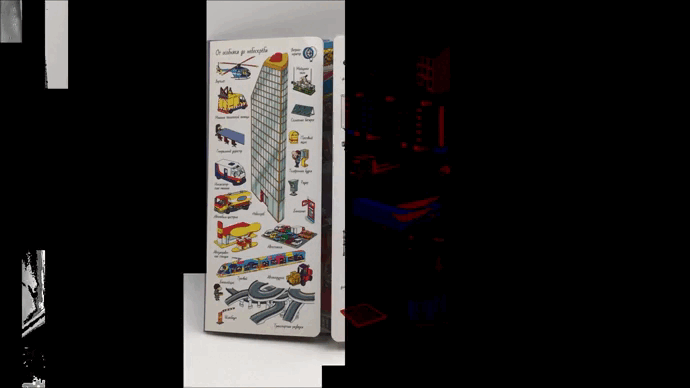


Animated picture books for children, also known as "animated board books" or "books with sliding pictures," are books with cardboard pages that include interactive elements that move or animate when they set in motion by the reader.
These books are designed for young children, who can enjoy the moving images and surprises hidden within the pages.
These books offer an interactive and engaging experience for children, encouraging them to actively participate in reading and stimulating their imagination and curiosity.
These books are also resistant and suitable for little children, thanks to their rigid cardboard structure.

Board books with pages containing windows are another popular variant of interactive books for children.
Windows, usually cut into the page, allow children to discover what lies behind them as they turn the pages.
These books are ideal for engaging children in history and encouraging them to explore and discover new things.
Books with windows offer children an added component of surprise and discovery as they read.
The books with windows engage young readers to explore the contents of the pages and stimulate their minds.

Board books that contain puzzles are a fun and interactive option for engaging young readers.
These books usually include pages with removable puzzle pieces, which children can assemble to complete a picture or scene.
Puzzle books offer children a hands-on, tactile learning experience.
They are a fun way to develop hand-eye coordination, problem solving, and concentration.
The puzzles inside the cardboard books are made from thick, durable cardboard, specially designed for small children's hands.
Pieces are shaped to fit a specific space on the page.
Puzzle ranges can vary from simple color or shape matches to more detailed images that require assembling multiple pieces.


Hardcover children's books with cardboard pages are a strong and durable option for little readers.
These books have a more solid and robust cover, generally made of reinforced or plasticized cardboard.
Here are some main points about children's hardcover books with cardboard pages:
-
Durability: The hard cover offers greater resistance and protection to the book pages. It makes hardcover books more suitable for younger children who may be prone to tearing o chewing pages.
The hardcover helps preserve the book over time, making it an ideal choice for families who want durable books that can be used for many readings. -
Solid construction: Hardcover cardboard books retain their shape and integrity even with intensive use. It makes them ideal for children who may treat them with some energy while reading and exploring.
The solid structure also contributes to better handling of the pages, allowing children to turn them without damaging the book. -
Images and text: Hardcover books with cardboard pages can feature bright, colorful pictures and text printed clearly and legibly.
The hard cover provides a stable surface for viewing the illustrations, allowing children to fully enjoy the images and stories.
In summary, hardcover board books offer durability, sturdiness, and long life, making them an excellent choice for younger children.
They are designed to withstand frequent use and provide a pleasant reading experience with bright images and readable text.

Board books with paperboard covers are a popular choice for younger children.
These books feature thick cardboard pages and a soft cover, making them easy to handle and suitable for the hands.
Here are some main points about children's books with paperboard covers:
-
Durability: The thick cardboard used for children's book pages resists wear and tear. The pages are durable and hard to break, making them suitable for young children's tactile exploration.
-
Ease of handling: The flexible paperboard cover allows children to easily handle the book, turn the pages, and hold it comfortably. The flexible cover allows parents to easily open and position books for reading.
-
Safety: Cardboard cover books are designed with child safety in mind. The cover and pages have no sharp edges or parts that could cause injury. Additionally, the cardboard used is generally toxic-free and safe for children to put in their mouths.
-
Images and text: Board books often feature bright pictures and simple text. The illustrations are colorful and attractive to catch children's attention. The text is short and easy to understand, suitable for beginning readers.
In summary, softcover board books are an excellent choice for younger children.
They are durable, easy to handle and safe.

Shaped Children's board books feature die-cut to create interesting shapes and contours.
This shaping technique adds an element of interactivity and sensory stimulation to the reading experience.
Here are some key points about shaped children's books :
-
Shapes and Contours: Contoured board book pages are cut to create shapes, contours, or openings that add a visual and tactile element to the reading experience. For example, there might be holes for the characters' fingers or silhouettes representing objects or animals.
-
Sensory Engagement: Shaping the pages provides additional sensory engagement for children. They can touch the die-cut shapes and explore the different textures or contours. This stimulates their sense of touch and encourages them to actively explore the book while reading.
-
Narrative Engagement: Page shaping can be designed to follow a specific story or theme. For example, the shaped holes could represent the windows of a house that the characters look out into. This narrative engagement helps children connect the reading activity with the plot and sequence of events.
-
Imagination Stimulation: Shaping the pages stimulates children's imagination, encouraging them to complete the shapes or imagine what could be beyond the shapes. This can encourage creativity and mental processing of the stories or concepts presented in the book.
-
Visual Appeal: The shaping of the pages adds an interesting visual element to children's books. The cut-out shapes and eye-catching outlines capture children's attention and invite them to explore the book further.
In summary, shaped books for children offer an interactive, engaging, and stimulating reading experience.
The cut shapes enrich the tactility and visual appeal of the book, stimulating children's senses and imagination.



